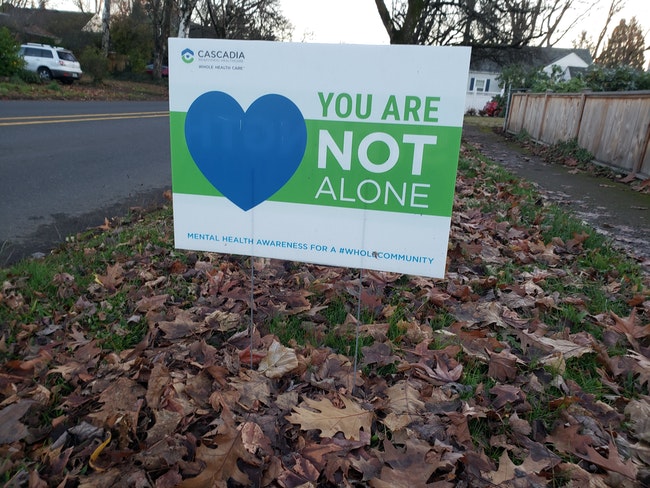
A mental health awareness sign along 17th Street in Salem on Dec. 1 (Rachel Alexander/Salem Reporter)
The crisis hotline serving Marion and Polk counties saw a significant increase in calls from people considering suicide in 2020.
From 2019 to 2020, the number of calls to the local hotline related to suicidal thoughts jumped 93%, from 1,166 to 2,249, according to data provided by Stephen Goins, Northwest Human Services transitional programs director, which operates the local crisis line.
“That’s huge and we see a lot of those numbers being as high as they are as a direct result of the pandemic,” Goins said.
Goins recently pulled the data ahead of National Suicide Prevention Month in September.
People in crisis who call the National Suicide Prevention Lifeline are routed to a more local group that maintains a crisis hotline. In Oregon, calls from Marion and Polk counties go to Northwest Human Services, while those from other areas are sent to Lines for Life in Portland.
Goins said the overall number of calls to the crisis line remained steady between from 2019 to 2020, but there was an uptick in calls from people who were considering suicide.
He said hotline workers help those callers through safety plans, presenting options to combat the hopelessness people feel. That can involve coping strategies, identifying warning signs, and people or agencies they can call for help.
In 2019, crisis workers developed 392 safety plans for people who were suicidal. Last year, they created 585 safety plans.
“Even just the social climate of 2020 and all the stuff we’ve gone through that’s put people in distress when you couple that with isolation,” Goins said. “We’re helping people sort through a plan and sometime that does the trick.”
Despite the increase in calls, statewide there were 90 fewer suicides across all ages last year compared to 2019, according to preliminary data released by the Oregon Health Authority in March.
In 2019, 906 Oregonians died by suicide, giving the state the ninth highest suicide ranking nationwide, according to the most recent data from the Centers for Disease Control and Prevention.
In 2018, 844 people died by suicide.
Goins said while risk assessments and safety plans increased by 60% and 49% respectively, the number of interventions by police and emergency medical services remained static.
“This is good evidence attesting to the effectiveness of crisis hotline services in meeting crisis needs while minimizing the impact upon police, EMS and hospital services,” he said in an email.
Goins also said the crisis line is taking more calls from youth and adolescents than it’s ever seen.
“Crisis services for youth just aren’t there,” he said. “We’re looking at that going, ‘We need to make sure that we’re on the ball and staying sharp.’”
The Salem-Keizer School District has a webpage for suicide prevention which directs students to the national hotline and offers other resources that breathing techniques and a teen message board. The district also conducts suicide risk assessments for students who report they’re struggling with suicidal thoughts.
The Marion Polk Community Health Improvement Plan, crafted by area health departments and hospitals, cites a goal of decreasing the suicide rate in Marion and Polk counties by 5% by 2025.
In 2018, Marion County saw 63 deaths by suicide and Polk County saw 13 deaths by suicide, according to the plan.
If you are experiencing a crisis, call Northwest Human Services Hotline at 503.581.5535 or 1.800.560.5535. The National Suicide Prevention hotline is 1-800-273-8255.
Contact reporter Saphara Harrell at 503-549-6250, [email protected].
JUST THE FACTS, FOR SALEM – We report on your community with care and depth, fairness and accuracy. Get local news that matters to you. Subscribe to Salem Reporter starting at $5 a month. Click I want to subscribe!









